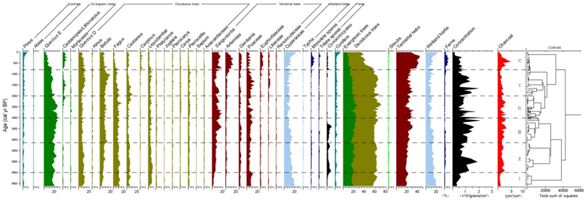A growing body of evidence continues to provide a broad outline of Holocene environmental changes in China, and in great detail for some regions. Comparatively the central China remains relatively unknown and some interpretation on environment and climate changes are somewhat controversial. Humans have been in the region for a long time, but little has been written on vegetation change and landscape transformation by human impact.The Dajiuhu peat and lake complex is one of the few extensive sub-alpine peatlands in central China.
Recently, a study conducted by Prof. YAN Hong’s team from the Institute of Earth Environment (IEE) of the Chinese Academy of Sciences, was published in Quaternary Science Reviews. They investigated a high-resolution peat core near the Dajiuhu peatland edge which was intended to better capture terrestrial vegetation dynamics.
A 6100 yr palynologic record, together with total organic carbon(TOC) and charcoal data, from Dajiuhu peatland was assessed to examine Holocene records of climate more closely for central China and identify the signal of human impact and its effects on environment and vegetation.
They found that wetland herb pollen was a sensitive marker of effective precipitation, and the ratio of evergreen and deciduous tree pollen could be a proxy for temperature variability at the site. A mixed evergreen and deciduous forest dominated the record.
Peak warming was at 2900 cal yr BP and cool events occurred around 5100, 4100 and 2700 cal yr BP. The cooling at 5100 and 2700 cal yr BP may be related to the decreased solar activity. There was a long-term drying trend punctuated by episodic droughts around 3000 to 2800 cal yr BP and following 1500 cal yr BP; they argued that these might be related to the southward retreat of the ITCZ.
A low level of regional fires was present as background. At 800 cal yr BP there were declines in forest taxa, increases in ferns, herbs, burning and inorganic inputs into the sediment; these signal sustained human impact in the area. The relatively late human impact was probably related to the rugged mountain landscape and river systems prone to frequent flooding, or may be due to a late expansion in human population and land resource pressures at Dajiuhu.
This work was supported by the research Projects from Chinese Academy of Sciences, Pilot National Laboratory for Marine Science and Technology (Qingdao), and the National Natural Science Foundation of China.

Fig.1. Pollen diagram showing abundance of main pollen and spore types, calculated against a pollen sum of total terrestrial pollen, the concentration and the charcoal. (Imaged by LU, Fengyan, et al.)

Fig.2. Selected palaeoenvironmental proxy indices from this work and other paleoclimatic records. (Imaged by LU, Fengyan, et al.)
Contact: Bai Jie, Institute of Earth Environment, Chinese Academy of Sciences, Xi'an, China. Email: baijie@ieecas.cn
 © 2015 Institute of Earth Environment,CAS
© 2015 Institute of Earth Environment,CAS Address:No. 97 Yanxiang Road, Xi'an 710061, Shaanxi, China

 Location :
Location :